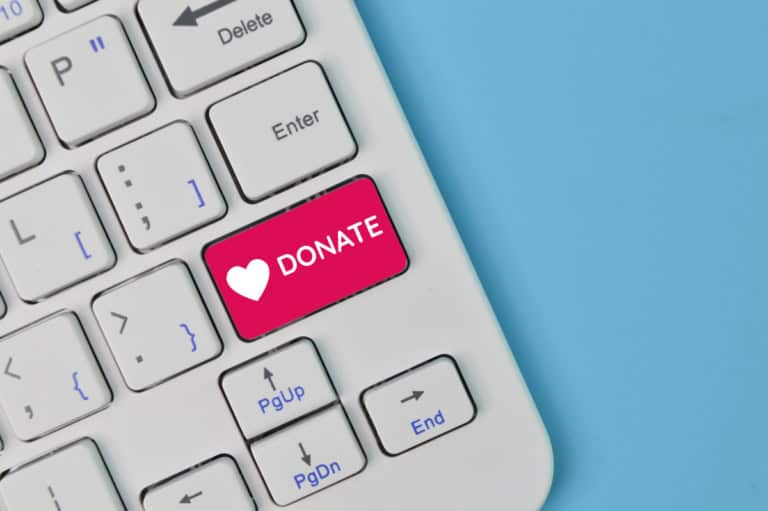Your donation page is more than just a form, it’s the moment of truth. A cluttered, slow, or confusing experience can turn generosity into hesitation. These 7 proven tips will help you simplify, streamline, and supercharge your donation page to raise more for your cause.
At Holler Digital, we’ve seen firsthand how powerful a well-optimized donation page can be. We’ve helped nonprofits raise millions of dollars through strategic improvements to their online giving experiences.
-
We helped Edmonton’s Lemonade Stand Day raise over $1 million online by building a custom donation platform.
-
We helped One Mind Institute simplify their online giving experience, leading to a noticeable increase in average donation amounts.
-
We partnered with the Alberta Beverage and Container Association to build initiatives that diverted millions of beverage containers from landfills.
-
We’re currently working with the Alberta Cancer Foundation to improve their online fundraising efforts and enhance the donor experience.
Every small improvement matters — and these are the same strategies we use to help organizations maximize their impact.
1. Keep the Page Simple with One Clear Focus: The Donation Form
When it comes to web design for nonprofits, simplicity wins. Your donation page should have one job, to encourage people to complete the donation form. That means removing anything that might distract or derail that goal. No menus competing for attention. No sidebars pulling focus. No “learn more” links halfway through the form.
If your organization offers multiple ways to give, such as monthly giving, planned giving, stock donations, or corporate matching, each method deserves its own dedicated page. Why? Because lumping all options together creates confusion and decision fatigue.
Instead, link to other donation options below the primary call to action or on a secondary page (like “Other Ways to Give”), but don’t let them compete with the main action of the page. You want to guide the donor down a clear, focused path and not send them into a maze of choices.
Remember: a streamlined user experience is good web design, good for conversion, and good for donors who just want to help.
2. Keep the Donation Form Above the Fold
Strategic web design also means understanding how users interact with your page. People have short attention spans, and the longer it takes for them to find the donation form, the more likely they are to leave without giving.
Make sure the form is placed near the top of the page — above the fold — so users can take immediate action without needing to scroll. Especially on mobile devices, every extra swipe increases the chance of losing a donor.
And don’t waste precious space with oversized hero images or decorative banners. Save the beautiful photography for a different page. Here, the goal is simple: get the donation form in front of the user’s face as quickly and clearly as possible. Action first, everything else second.
When it comes to donation pages, clarity beats creativity every time.
3. Reduce Decision Fatigue with Suggested Donation Amounts
Too many choices can overwhelm people, and when donors feel overwhelmed, they hesitate or leave. Help them take action faster by offering suggested donation amounts right on the form.
Even better, tie each suggested amount to a real-world impact:
-
$25 = School supplies for one student
-
$50 = A week’s worth of meals for a family
-
$100 = Emergency shelter for one night
This not only makes the decision easier but also emotionally connects the donor’s contribution to a tangible result — a proven way to boost conversions.
Including these specifics also benefits your SEO strategy: donation pages that mention the outcomes of donations (“provide meals,” “support education,” “fund shelter”) can rank better for highly motivated, action-driven search terms.
Pro tip: Offer 3–5 suggested amounts to avoid overwhelming users, but always leave a “custom amount” option available for maximum flexibility.
4. Allow Your Donors to Cover the Transaction Fee
Processing fees are a quiet but persistent drain on nonprofit revenue. Every time someone donates, a small percentage gets siphoned off to cover credit card or platform fees. But here’s the good news: many donors are more than willing to help — they just need to be asked.
By adding a simple checkbox that allows donors to cover the transaction fee, you empower them to ensure 100% of their intended gift goes to your cause. It’s a small design detail with a big payoff.
This is a great example of how smart web design can support your fundraising goals without adding complexity for the donor. It feels optional (because it is), but it frequently leads to a meaningful increase in net revenue — especially for high-volume campaigns.
5. Optimize for Performance and Mobile Users
A slow website isn’t just frustrating, it’s expensive. Every second your page takes to load increases the chance of a donor abandoning their gift. Performance is critical, and it starts with strong web hosting. Make sure your site is running on a fast, reliable hosting platform that prioritizes speed, security, and uptime.
But great web hosting is just the beginning. Pair it with smart SEO practices like compressing images, using lazy loading for media, minimizing third-party scripts, and streamlining your site’s code.
And don’t forget about mobile users — for many nonprofits, mobile traffic now accounts for the majority of visits. Your donation page needs to load fast, look great, and work flawlessly on every device and connection speed.
Pro Tip: If you’re planning a major campaign, event, or Giving Day (like we do for Lemonade Stand Day), consider temporarily upgrading your web hosting plan during peak periods. A surge of traffic can crash an underprepared site, but with the right infrastructure in place, you’ll stay online and keep donations flowing when it matters most.
Fast-loading, mobile-optimized pages don’t just improve user experience, they also boost your SEO rankings, making it easier for people to find and support your cause.
6. Build Trust with Visual and Written Cues
Trust is everything when you’re asking someone to part with their hard-earned money. Donors need to feel confident that their gift is secure and going to a legitimate cause.
Strong web design supports this by layering in trust signals throughout the donation page. Add visible SSL security badges, recognizable nonprofit certifications (like Charity Navigator ratings or BBB accreditations), and simple, reassuring statements about how donations will be used.
Even something as small as a note that says “100% of your donation goes directly to support [your mission]” can make a big difference in a donor’s decision to complete their gift.
Remember, trust isn’t built through one flashy graphic — it’s built through a series of small, consistent visual and written cues that together create a feeling of safety and credibility.
7. Track Donation Metrics in Google Analytics
You can’t improve what you don’t measure. If you want to raise more funds online, tracking your donation page performance is non-negotiable.
Set up Google Analytics 4 (GA4) to monitor critical actions like:
-
Donation page views
-
Donation form clicks
-
Completed donations (such as thank-you page visits or ecommerce events)
Tracking these key metrics helps you spot exactly where donors are falling off — whether it’s a slow-loading page, a confusing form, or a missed mobile optimization.
It’s also a vital part of a strong SEO strategy: better data leads to better decisions about how to structure your content, improve user experience, and ultimately drive more traffic and conversions.
Pro Tip: If you’re running multiple donation campaigns, track them separately with custom events or UTM parameters so you can measure each campaign’s performance more accurately.
Bonus Tip: Use a CRM to Nurture Donors and Encourage Repeat Giving
Getting the donation is just the beginning — what you do afterward matters just as much. A CRM (Customer Relationship Management) system can help you immediately thank donors, show them the impact of their gift, and keep them engaged with your mission.
Automated thank-you emails, personalized impact updates, and milestone celebrations make donors feel seen and appreciated. And donors who feel connected to your cause are far more likely to give again — or even become monthly supporters.
A good CRM integrated into your website doesn’t just streamline your donor communications — it helps build long-term relationships that fuel sustainable growth.
Pro Tip: Even a simple automated thank-you email can dramatically improve donor satisfaction and retention rates — but if you want to take it a step further, add a short personal video thank-you on your confirmation page or through a service like Bonjoro. A little face-to-face gratitude goes a long way.
Conclusion
Your donation page is one of the most important tools your nonprofit has — but even small issues can cost you support. By simplifying the experience, building trust, optimizing performance, and tracking the right metrics, you can turn more visitors into loyal donors.
If you’re serious about raising more funds online, don’t leave it to chance.
Get a Free Donation Page and Website Audit
At Holler Digital, we’ve helped nonprofits like Edmonton’s Lemonade Stand Day and One Mind Institute raise millions through smarter web design, SEO, and hosting strategies. Now, we’re offering a free audit of your donation page and website to help you spot opportunities for improvement.
We’ll review:
-
Donation page layout and conversion optimization
-
Website performance, hosting, and mobile usability
-
Trust-building elements and messaging
-
SEO opportunities to drive more traffic
-
CRM integration opportunities to nurture donors
Ready to raise more funds and build stronger donor relationships?



